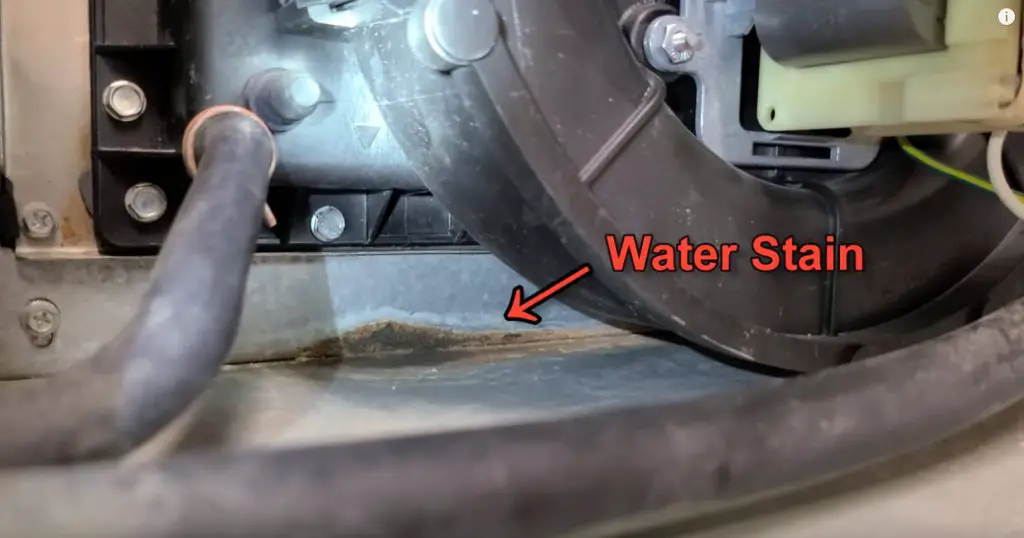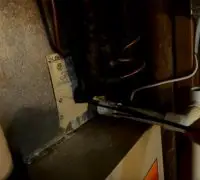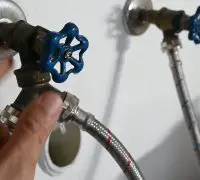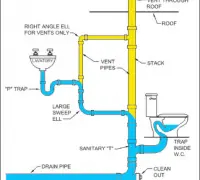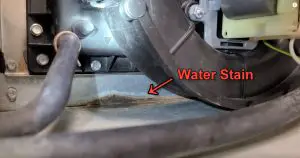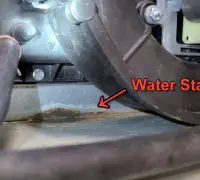Even if finding water around the furnace isn’t great, it’s not the worst thing that can happen with a furnace (most of the time, anyway). A condensation leak in a furnace can have many reasons, with a damaged condensation drain being the most common.
Don’t panic the moment you notice condensation from your furnace. More often than not, condensation leak in the furnace has an easy fix. It would help if you didn’t postpone the fixing and you might have to call a certified technician. A pool of water around the furnace can lead to flooding, increase the risk of mold, and flood inside the furnace.
The condensation leak in your furnace can happen for some reasons in high-efficiency gas furnaces; standard-efficiency gas furnaces have other causes for leaking water. Even if you need to call the HVAC technician to fix the condensation leak in your furnace, it’s wise to learn the essentials about what might be the causes.
Page Table of Contents
Do you know which type of furnace you have?
You need to know which furnace you have to identify the cause of the water leaking. Condensation leaks are only familiar to gas furnaces, but you need to know which of the two types you have: a high-efficiency gas furnace or a standard-efficiency furnace. Most of the time (80%), the condensation leak occurs with high-efficiency gas condensing furnaces.
Since standard-efficiency furnaces shouldn’t leak water, condensation leaking in the winter is more familiar with high-efficiency gas furnaces. There’s no condensation when running the standard-efficiency furnaces, but it involves high-efficiency furnaces. Here’s how you can tell which of the two you have:
Examine the condensation pipe
High-efficiency furnaces have a white plastic pipe (PVC exhaust pipe) for drainage, whereas standard-efficiency furnaces come with a metal exhaust pipe or a flue pipe. The condensation pipe should is placed at the back of the furnace.
AFUE rating
High-efficiency furnaces have above 90 AFUE (Annual Fuel Utilization Efficiency) rating, which means they have 90% energy efficiency. On the other hand, standard-efficiency furnaces have a below 90 AFUE rating. Typically, the high-efficiency furnaces will present a yellow sticker with a listed AFUE rating.
How do high-efficiency gas furnaces operate?
High-efficiency furnaces reach above 90% of the energy produced by burning gas. Even though this impressive performance, it increases the risk of condensation leaks. High-efficiency furnaces use a secondary heat exchanger to extract more heat, which cools the generated gas condensation will appear as the gases cool down.
All high-efficiency furnaces come with a condensation drain (PVC exhaust pipe). The condensation should be vented through the drain as long as the furnace runs correctly. A malfunctioning drainage system can make the condensation leak abnormally.
What are the causes of condensation leaks? What are the solutions?
There are three main reasons you discover a condensation leak in your furnace.
The condensation pipe is clogged
When it runs adequately, a free flow of water (condensate is a side product that appears from extracting extra energy from the burning gas) occurs in the furnace PVC overflow pipe. If there’s a clog, the free flow will stop.
Accumulated dirt, dust, mold, and even ice might clog the condensation tubing. When you run the furnace, condensation will occur and come out of the furnace through the pipe. When the pipe is clogged, the water will accumulate within the furnace. In time, the accumulated water will begin to drip out of the furnace—the water that comes from your furnace’s bottom.
The fix
You only need to unclog the pipe with some pan tablets. It’s not as easy as it sounds, though. You will have to open the gas chamber to drain the pipe and you should leave the job to a certified furnace technician. There are many moving parts to deal with in there. Additionally, the condensate trap can also be clogged.
After unclogging the PVC exhaust pipe, you must put the furnace back together. When you rerun the furnace, water will go through the unclogged pipe out and away from the furnace.
A clogged condensation pipe represents the furnace’s most common cause of condensation leaks. It typically happens in the winter, as you haven’t used the furnace in the summer, so mold, dust, and dirt have time to collect and clog the PVC pipe.
The condensation pipe is leaking
When the furnace is dripping water, a leaking drain pipe might cause it. The problem is similar to a clogged exhaust pipe, but a hole in the pipe is the cause. The problem only occurs with high-efficiency furnaces because they come with PVC pipes that can be pierced from wear and tear. A hole will form and a small amount of water will drip. Since standard-efficiency furnaces come with metal exhaust pipes or metal flue, the pipes won’t easily break, so there will be no holes and water dripping.
When there’s a hole in the pipe, water will start dripping out of the furnace, but in small amounts. There will be more water with a clogged drain pipe than with a leaking condensation pipe. Check out the pipe, as you will notice water dripping from the furnace vent pipe.
The fix
You can either fix the leak or replace the pipe. Fixing the leak is often possible, but many people decide to replace the drain pipe. It’s a cheap standard PVC pipe that you can find in every hardware store.
To fix the pipe, you will need to dismantle and reassemble the furnace, which is something better left to the professionals.
Problems with the condensation pump (water accumulation)
The condensation pump generates pressures that push the condensate through the PVC vent pipe and away from the furnace. It’s the most effective method to remove condensation from the furnace. The gas furnace won’t perform properly when the condensation pump doesn’t run correctly. A faulty condensation pump could be the culprit in your furnace’s condensation leak.
The fix
You will have to fix or, better yet, replace the pump. We recommend you make sure that the problem is a faulty pump. A certified technician should examine the pump and decide if repair or replacement is the solution. As the pump is less than $50, most technicians recommend replacement.
Once the condensation pump runs correctly again, there will be no more condensation leaking from the furnace.
Wrong size for the exhaust pipe
Leaks aren’t familiar with standard-efficiency gas furnaces as they don’t involve condensation. If condensation does happen with the older models, they have metal exhaust pipes that are stronger and safer than PVC exhaust pipes.
If you have a standard-efficiency furnace and condensation occurs, water will start leaking from the overflow pipe. If this happens, the exhaust pipe has the wrong size. The pipe (without a condensation pump) is too small to permit proper drainage. The leading cause can be a malfunctioning heat exchanger to gas leakage.
The fix
Even if you might think that you should change the pipe and install a bigger exhaust pipe, you’re not going to eliminate the primary cause. The thing is that there should not be condensation in your furnace, to begin with. We recommend you call a certified technician to see why your standard-efficiency furnace produces condensation in the first place. Some problems don’t have fixes and furnace replacement is the only solution.
The internal drain system is clogged
The leaking AC drain might flood the furnace if the air conditioner is connected to the furnace (AC furnace). It’s a common cause of leaking water furnaces in the summer. During summer, the air conditioner extracts a lot of water moisture from indoor air and the collected water is removed through the drain pipe.
When the AC furnace starts leaking water, it’s probably because the AC and furnace have the same internal drain. If the drain is clogged, the water from the air conditioner might be directed toward the furnace. You will notice water coming out from the furnace and not understand why because you’re not using the furnace in the summer.
The fix
It will help to unclog the furnace and air conditioner’s internal drain. It’s not necessary to disassemble the AC or furnace to find the internal drain. Repairing the water leaking repair is a DIY job. After you remove the clog, the air conditioner will drain adequately and won’t send water to the furnace anymore.
Faulty whole-house humidifier
Some gas furnaces come with a whole-house humidifier, which we know holds plenty of water. As the furnace and the whole-house humidifier are connected, any problems with the humidifier will flood the furnace.
In the beginning, you will notice water coming from the furnace. If you think the whole-house humidifier causes the water underneath the furnace, you should verify the humidifier. When the humidifier requires refilling more often than usual, it probably doesn’t use all the water. Some of that water might get to the furnace and flood it.
The fix
Call the HVAC technician to check out the furnace and the whole-house humidifier. He will know for sure if the water underneath the furnace comes from the faulty humidifier or not.
The secondary heat exchanger is faulty
Only high-efficiency 90+ AFUE rating furnaces come with a secondary heat exchanger—where additional heat is extracted from the gas. The gas will cool and generate condensation in the furnace. When the secondary heat exchanger isn’t running correctly, it might produce more condensation. When the amount of condensate is more than the PVC overflow vent pipe can manage, water will come out from the furnace.
Unlike other problems, it’s difficult to say what happened to the secondary heat exchanger. Repairs are seldom possible.
The fix:
Sadly, you will have to buy a new furnace. It’s only rare that it’s possible to repair the secondary heat exchanger; such service is rather expensive. Should a faulty secondary heat exchanger cause condensation in your furnace, you will need to go shopping for a new furnace.
